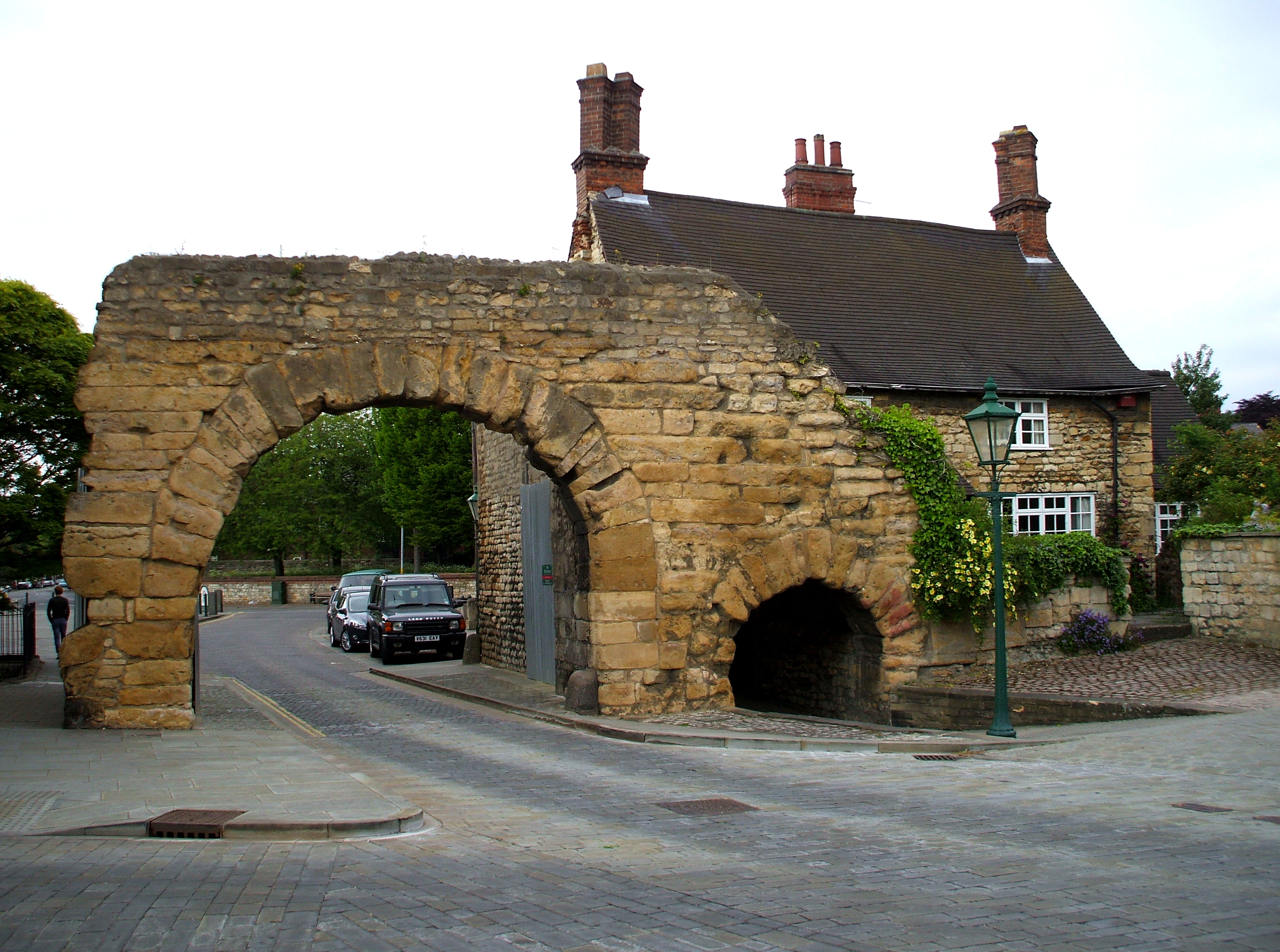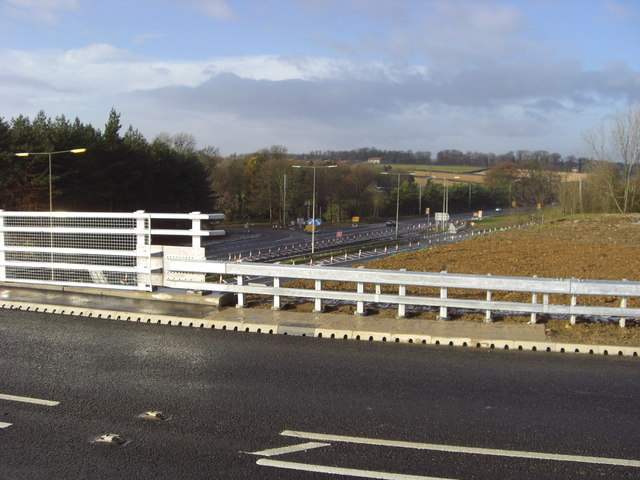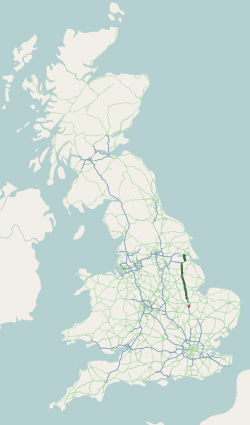|
Ashby De La Launde And Bloxholm
Ashby de la Launde and Bloxholm is a civil parish in the North Kesteven district of Lincolnshire, England. According to the 2001 Census it had a population of 796, increasing to 837 at the 2011 census. The parish includes the villages of Ashby de la Launde and Bloxholm, and the southern part of Scopwick Heath. For administrative reasons the parish council is also responsible for the adjacent parish of Temple Bruer with Temple High Grange. Description The two parishes straddle the A15 in between Lincoln and Sleaford. The Temple Bruer parish is entirely rural, containing the farm and Knights Templar ruins to the west of the A15, and a hamlet at Thompson's bottom. The Ashby del la Launde parish contains most of the village of Ashby de la Launde and the hamlet of Bloxholm. Ashby de la Launde is a village to the east of the A15 road, based around two centres. The first, Main Street, is centred on the church, the old Hall, and Home Farm. The second is around RAF Digby, with the ... [...More Info...] [...Related Items...] OR: [Wikipedia] [Google] [Baidu] |
Civil Parish
In England, a civil parish is a type of Parish (administrative division), administrative parish used for Local government in England, local government. It is a territorial designation which is the lowest tier of local government below districts of England, districts and metropolitan and non-metropolitan counties of England, counties, or their combined form, the Unitary authorities of England, unitary authority. Civil parishes can trace their origin to the ancient system of Parish (Church of England), ecclesiastical parishes, which historically played a role in both secular and religious administration. Civil and religious parishes were formally differentiated in the 19th century and are now entirely separate. Civil parishes in their modern form came into being through the Local Government Act 1894, which established elected Parish councils in England, parish councils to take on the secular functions of the vestry, parish vestry. A civil parish can range in size from a sparsely ... [...More Info...] [...Related Items...] OR: [Wikipedia] [Google] [Baidu] |
Sleaford
Sleaford is a market town and civil parish in the North Kesteven district of Lincolnshire, England. Centred on the former parish of New Sleaford, the modern boundaries and urban area include Quarrington to the south-west, Holdingham to the north and Old Sleaford to the east. The town is on the edge of the fertile Fenlands, north-east of Grantham, west of Boston, and south of Lincoln. Its population of 17,671 at the 2011 Census made it the largest settlement in the North Kesteven district; it is the district's administrative centre. Bypassed by the A17 and the A15, it is linked to Lincoln, Newark, Peterborough, Grantham and King's Lynn. The first settlement formed in the Iron Age where a prehistoric track crossed the River Slea. It was a tribal centre and home to a mint for the Corieltauvi in the 1st centuries BC and AD. Evidence of Roman and Anglo-Saxon settlement has been found. The medieval records differentiate between Old and New Sleaford, the latter emerg ... [...More Info...] [...Related Items...] OR: [Wikipedia] [Google] [Baidu] |
Ermine Street
Ermine Street is a major Roman road in England that ran from London (''Londinium'') to Lincoln ('' Lindum Colonia'') and York (''Eboracum''). The Old English name was ''Earninga Strǣt'' (1012), named after a tribe called the ''Earningas'', who inhabited a district later known as ''Armingford Hundred'', around Arrington, Cambridgeshire, and Royston, Hertfordshire. "Armingford", and "Arrington" share the same Old English origin. The original Celtic and Roman names for the route remain unknown. It is also known as the Old North Road from London to where it joins the A1 Great North Road near Godmanchester. Course Ermine Street begins at Bishopsgate, where one of the seven gates in the wall surrounding Roman London was located. From here it runs north up Norton Folgate, Shoreditch High Street and Kingsland Road through Stoke Newington (forming Stoke Newington Road and Stoke Newington High Street), Tottenham, Edmonton and eastern Enfield (Ponders End, Enfield Highw ... [...More Info...] [...Related Items...] OR: [Wikipedia] [Google] [Baidu] |
High Dyke, Lincolnshire
High Dyke is a minor road following a length of the Roman Road Ermine Street in the English county of Lincolnshire, between Woolsthorpe-by-Colsterworth and Ancaster, and onwards nearly to Bracebridge Heath. It is also the name of a small settlement on that road, south-east from Great Ponton, near to the mouth of Stoke Tunnel on the East Coast Main Line. High Dyke is also a name for the general area between Easton and Great Ponton. On the Ordnance Survey 1:25000 sheets it is spelled ''High Dike''. Junctions Recent rebuilding of the A1 road junction at Woolsthorpe-by-Colsterworth in 2008 has included construction of a grade-separated road crossing in place of the disused railway bridge that was part of the High Dyke branch, a mineral railway used to export iron ore between 1916 and 1973. There is a roundabout adjacent to Prince William of Gloucester Barracks east of Grantham, but all other junctions are conventional grade-level crossroads or T junctions. Route The mo ... [...More Info...] [...Related Items...] OR: [Wikipedia] [Google] [Baidu] |
Roman Roads In Britain
Roman roads in Britannia were initially designed for military use, created by the Roman Army during the nearly four centuries (AD 43–410) that Britannia was a province of the Roman Empire. It is estimated that about of paved trunk roads (surfaced roads running between two towns or cities) were constructed and maintained throughout the province. Most of the known network was complete by 180. The primary function of the network was to allow rapid movement of troops and military supplies, but it subsequently provided vital infrastructure for commerce, trade and the transportation of goods. A considerable number of Roman roads remained in daily use as core trunk roads for centuries after the end of Roman rule in Britain in 410. Some routes are now part of the UK's national road network. Others have been lost or are of archeological and historical interest only. After the Romans departed, systematic construction of paved highways in the United Kingdom did not resume unt ... [...More Info...] [...Related Items...] OR: [Wikipedia] [Google] [Baidu] |
RAF Digby
Royal Air Force Digby otherwise known as RAF Digby is a Royal Air Force station located near Scopwick and south east of Lincoln, in Lincolnshire, England. The station is home to the tri-service Joint Service Signals Organisation, part of the Joint Forces Intelligence Group of Joint Forces Command. Other units include the RAF Aerial Erector School, No. 54 Signals Unit and No. 591 Signals Unit. Formerly an RAF training and fighter airfield, it is one of the country's older Royal Air Force stations, predated only by RAF Northolt, which is the oldest and predates the Royal Air Force by three years, having opened in 1915. Flying at Digby ceased in 1953. History First World War There are dated photographs that show that the airfield was already in use for flying training by Royal Naval pilots in the summer of 1917, although no documents supporting this have ever been found. The photographs show contemporary hangars, sheds and aircraft already in place around grassed runways and uni ... [...More Info...] [...Related Items...] OR: [Wikipedia] [Google] [Baidu] |
Knights Templar
The Poor Fellow-Soldiers of Christ and of the Temple of Solomon ( la, Pauperes commilitones Christi Templique Salomonici), also known as the Order of Solomon's Temple, the Knights Templar, or simply the Templars, was a Catholic military order, one of the most wealthy and popular military orders in Western Christianity. They were founded in 1119, headquartered on the Temple Mount in Jerusalem, and existed for nearly two centuries during the Middle Ages. Officially endorsed by the Roman Catholic Church by such decrees as the papal bull '' Omne datum optimum'' of Pope Innocent II, the Templars became a favored charity throughout Christendom and grew rapidly in membership and power. Templar knights, in their distinctive white mantles with a red cross, were amongst the most skilled fighting units of the Crusades. They were prominent in Christian finance; non-combatant members of the order, who made up as much as 90% of their members, managed a large economic infrastructure throu ... [...More Info...] [...Related Items...] OR: [Wikipedia] [Google] [Baidu] |
Temple Bruer
Temple Bruer with Temple High Grange is a civil parish and a former extra-parochial area in North Kesteven, Lincolnshire, which had in the Medieval period been held by the Knights Templar and later by the Knights Hospitaller of Temple Bruer Preceptory. By an Act of Parliament passed on 5 March 1879, Temple Bruer with Temple High Grange was constituted as a parish. At that time the parish was in Flaxwell wapentake, Sleaford Union and County Court district, and the ecclesiastical rural deanery of Longobody. The parish lies to the southeast of Lincoln, southeast of Navenby and northwest of Sleaford. Wellingore and Welbourn parishes lie to the west and Brauncewell to the south. The old Roman road, Ermine Street, passes through the western edge of the parish, which at this point is a bridleway not a modern road. Temple High Grange is part of the parish. The parish covered about . The parish is now within the electoral area of Ashby de la Launde and Cranwell Ward in North Kesteven ... [...More Info...] [...Related Items...] OR: [Wikipedia] [Google] [Baidu] |
Lincoln, Lincolnshire
Lincoln () is a cathedral city, a non-metropolitan district, and the county town of Lincolnshire, England. In the 2021 Census, the Lincoln district had a population of 103,813. The 2011 census gave the Lincoln Urban Area, urban area of Lincoln, including North Hykeham and Waddington, Lincolnshire, Waddington, a population of 115,000. Roman Britain, Roman ''Lindum Colonia'' developed from an Iron Age settlement on the River Witham. Landmarks include Lincoln Cathedral (English Gothic architecture; for over 200 years the world's tallest building) and the 11th-century Norman architecture, Norman Lincoln Castle. The city hosts the University of Lincoln, Bishop Grosseteste University, Lincoln City F.C., Lincoln City FC and Lincoln United F.C., Lincoln United FC. Lincoln is the largest settlement in Lincolnshire, with the towns of Grimsby second largest and Scunthorpe third. History Earliest history: ''Lincoln'' The earliest origins of Lincoln can be traced to remains of an Iron Ag ... [...More Info...] [...Related Items...] OR: [Wikipedia] [Google] [Baidu] |
North Kesteven
North Kesteven is a local government district in Lincolnshire, England. The district is located to the east of Nottinghamshire, north-east of Leicestershire and south of the city of Lincoln. Its council, North Kesteven District Council, is based in Sleaford in the former offices of Kesteven County Council. Notable towns and villages in the district include Cranwell, Metheringham, North Hykeham, Sleaford and Waddington. History The district was formed on 1 April 1974, under the Local Government Act 1972. It was a merger of the previous urban district of Sleaford, along with East Kesteven Rural District and North Kesteven Rural District, all from the administrative county of Kesteven, which was abolished. Geography North Kesteven borders West Lindsey (along the Foss Dyke and the River Witham) and the city of Lincoln to the north, East Lindsey to the north-east (along the River Witham), Boston (borough) to the east, South Holland to the south-east, South Kesteven ... [...More Info...] [...Related Items...] OR: [Wikipedia] [Google] [Baidu] |
A15 Road (England)
The A15 is a Major Road Network, major road in England. It runs north from Peterborough via Market Deeping, Bourne, Lincolnshire, Bourne, Sleaford and Lincoln, England, Lincoln along a variety of ancient, Roman roads in Britannia, Roman, and Turnpike trust, Turnpike alignments before it is interrupted at its junction with the M180 motorway, M180 near Scawby. The road restarts east, and then continues north past Barton-upon-Humber, crossing the Humber on the Humber Bridge before terminating at Hessle near Kingston upon Hull. Driving conditions According to The Automobile Association, the AA, the route is long, and should take 2 hours. Norman Cross to Bourne takes 33 minutes, Bourne to Lincoln takes 46 minutes, and Lincoln to the Humber Bridge takes 54 minutes. A section of the A15 (between Scampton and the M180 motorway, M180) provides the longest stretch of straight road in the UK. Route Peterborough The A15 is Peterborough's main connecting road from the south to the A1 ... [...More Info...] [...Related Items...] OR: [Wikipedia] [Google] [Baidu] |
Fields Off Navenby Lane - Geograph
Fields may refer to: Music * Fields (band), an indie rock band formed in 2006 * Fields (progressive rock band), a progressive rock band formed in 1971 * ''Fields'' (album), an LP by Swedish-based indie rock band Junip (2010) * "Fields", a song by Sponge from '' Rotting Piñata'' (1994) Businesses * Field's, a shopping centre in Denmark * Fields (department store), a chain of discount department stores in Alberta and British Columbia, Canada Places in the United States * Fields, Oregon, an unincorporated community * Fields (Frisco, Texas), an announced planned community Other uses * Fields (surname), a list of people with that name * Fields Avenue (other), various roads * Fields Institute, a research centre in mathematical sciences at the University of Toronto * Fields Medal, for outstanding achievement in mathematics * Caulfield Grammarians Football Club, also known as The Fields * FIELDS, a spacecraft instrument on the Parker Solar Probe See also * Mrs. Fi ... [...More Info...] [...Related Items...] OR: [Wikipedia] [Google] [Baidu] |








